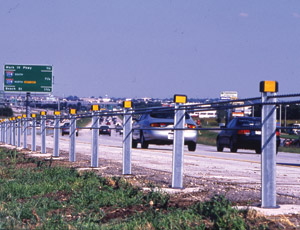TxDOT seems to have solved the problem of crossover collisions on IH-10 through San Antonio with the installation of a 17.2-mi section of cable barrier.

The stretch of highway had a history of crossover collisions—including seven fatalities in a three-year span—but since the placement in 2008, there have been no fatal crossover collisions.
“Cable median barriers prevent vehicles from crossing into oncoming traffic, Mark Cross, TxDOT spokesperson, tells Texas Construction. “Adding the cable median barriers decreases injuries and fatalities and it’s not as expensive as concrete barriers.”
In the past five years, TxDOT dedicated $1.2 billion to highway projects that had the greatest potential for reducing traffic crashes. The funds come from the Texas Safety Bond Program, which comprises 20% of the funds available from Proposition 14 highway bonding authority, approved by voters in 2003.
By the time all the safety bond projects are completed, TxDOT will have widened nearly 2,200 mi of narrow two-lane roads, added 272 left-turn lanes, built 38 highway interchanges and installed 1,030 mi of concrete and cable barrier, Cross says.
“Safer roads have played a significant part in reducing fatalities,” he adds. “Last year, there were 388 fewer fatalities on Texas highways, an 11% decrease from the prior year.”
TxDOT spokeswoman Kelli Petras says examples such as IH-10 in San Antonio demonstrate the effectiveness of the efforts.
“Any time there is a traffic accident on one of our roadways, we take note of reports, especially for fatalities,” Petras says. “It is rare that a number of accidents occur in one spot. In that particular area, there was not a lot of room to add concrete barriers or an extra lane, so cable barriers wee the best option.
“That’s just one example of how a piece of safety equipment can be priceless when it comes to saving lives.”

Post a comment to this article
Report Abusive Comment